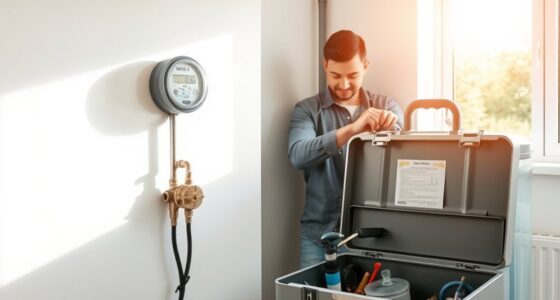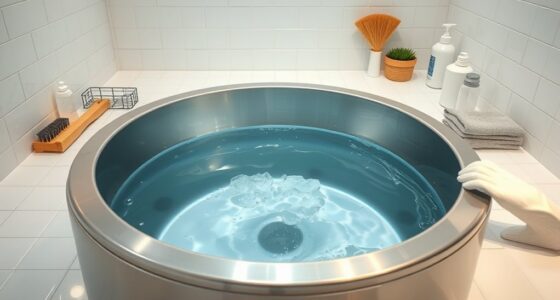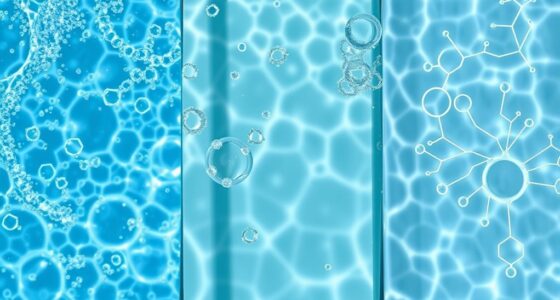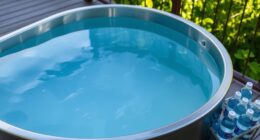To prevent algae growth in your cold plunge pool, keep the water’s chemical balance right by testing pH, alkalinity, and sanitizer levels regularly. Maintain strong filtration and circulate the water consistently to remove debris and spores. Limit sunlight exposure by covering the pool when not in use, and use algaecides as a preventative measure. Staying vigilant with these steps helps keep your pool clean and algae-free—discover more tips to keep your pool pristine.
Key Takeaways
- Maintain proper chemical balance, especially pH and sanitizer levels, to inhibit algae growth.
- Regularly clean and vacuum the pool to remove organic debris that feed algae.
- Use a pool cover when not in use to minimize sunlight exposure and heat, slowing algae development.
- Ensure the filtration system operates efficiently to trap spores and circulate water evenly.
- Apply algaecides preventatively, particularly during high temperatures or extended periods of inactivity.

Algae growth can quickly turn a clean pond, pool, or outdoor water feature into a murky, unsightly mess. If you’re managing a cold plunge pool, it’s essential to stay ahead of algae by maintaining proper pool sanitation and ensuring your chemical balance is just right. Algae thrive in environments where nutrients and organic matter accumulate, so regular cleaning and monitoring are key to preventing their growth. When your pool isn’t properly sanitized, it becomes a perfect breeding ground for algae, especially during warm or humid days.
To keep algae at bay, you need to focus on maintaining a consistent chemical balance. This means regularly testing your water for pH, alkalinity, and sanitizer levels. A proper pH, typically between 7.2 and 7.8, ensures that sanitizers like chlorine or bromine work effectively to kill algae spores. If the pH drifts outside this range, disinfectants become less effective, allowing algae to flourish. Similarly, maintaining appropriate sanitizer levels is critical; insufficient sanitization leaves your water vulnerable to algae growth and bacterial contamination. You should test your water frequently—at least once a week—and adjust chemicals accordingly to keep everything in ideal balance.
Pool sanitation isn’t just about chemicals, though. Regularly cleaning your pool’s surfaces, skimming debris, and vacuuming the bottom help remove organic matter that algae feed on. It’s also beneficial to keep your filtration system running efficiently, as a clean filter traps algae spores and other particles before they spread. Shock treatments can be useful after heavy use or if algae start to show signs of growth. These treatments boost sanitizer levels temporarily, destroying algae spores and preventing a small problem from escalating into a full-blown algae bloom.
Aside from chemical treatments, consider using algaecides as a preventative measure. They act as a safeguard, especially if your pool is exposed to sunlight or high temperatures, which accelerate algae growth. Keep the pool covered when not in use to limit sunlight exposure, reducing algae’s ability to photosynthesize and grow. Maintaining proper circulation is also essential, as stagnant water encourages algae growth. If your pool sits unused for a while, make sure to circulate the water periodically to prevent any algae from taking hold. Additionally, understanding the importance of Proper chemical balance can significantly reduce the risk of algae development and keep your pool crystal clear.
Frequently Asked Questions
How Often Should I Test My Cold Plunge Pool’s Water Chemistry?
You should test your cold plunge pool’s water chemistry at least twice a week to maintain ideal conditions. Regular water testing frequency helps you monitor chemical balance, ensuring proper pH and sanitizer levels. Keep an eye on your water’s clarity and smell, and adjust chemicals accordingly. Consistent chemical balance monitoring prevents algae growth, keeps your pool safe, and extends its lifespan, so make it a routine part of your pool maintenance.
Can Natural Remedies Effectively Prevent Algae Growth?
Natural remedies like biological treatments and mineral-based solutions can help prevent algae growth in your cold plunge pool. Biological treatments introduce beneficial organisms that outcompete algae, while mineral solutions, such as copper or silver, inhibit algae development naturally. These methods are eco-friendly and reduce chemical use, but you should still regularly test your water chemistry to guarantee effectiveness. Combining natural remedies with proper maintenance keeps your pool clear and algae-free.
What Are the Signs That Algae Has Already Started to Grow?
Did you know that algae can double in number every 24 hours under ideal conditions? You’ll notice algae has started to grow when you see a change in algae color, such as green, yellow, or black, and the surface feels slimy or sticky. These signs indicate that algae is taking hold, so it’s time to brush the pool walls and increase filtration to prevent it from spreading further.
Does the Type of Pool Surface Affect Algae Prevention?
Yes, the type of pool surface materials affects algae prevention. Smooth surfaces like fiberglass or vinyl are less likely to promote algae adhesion because algae find it harder to attach. Rougher surfaces, such as concrete or plaster, provide more nooks and crannies for algae to cling to, increasing the risk of growth. Choosing the right pool surface can make algae control easier, reducing the need for frequent cleaning and chemical treatments.
Are There Eco-Friendly Options for Algae Control in Cold Pools?
Yes, there are eco-friendly options for algae control in cold pools. You can use biodegradable pool treatments, which effectively combat algae while being gentle on the environment. These treatments often contain natural ingredients like enzymes or plant-based compounds, helping you keep your pool clean without harsh chemicals. Regular use of eco-friendly algae control methods minimizes environmental impact and keeps your cold plunge safe and enjoyable.
Conclusion
By regularly cleaning your cold plunge pool, maintaining proper sanitizer levels, and keeping it covered when not in use, you can effectively prevent algae growth. Consistency is key—stay vigilant, and algae won’t have a chance to take hold. Isn’t it worth the effort to enjoy a crystal-clear, invigorating plunge every time? With these simple steps, you’ll keep your pool clean and inviting all season long.









